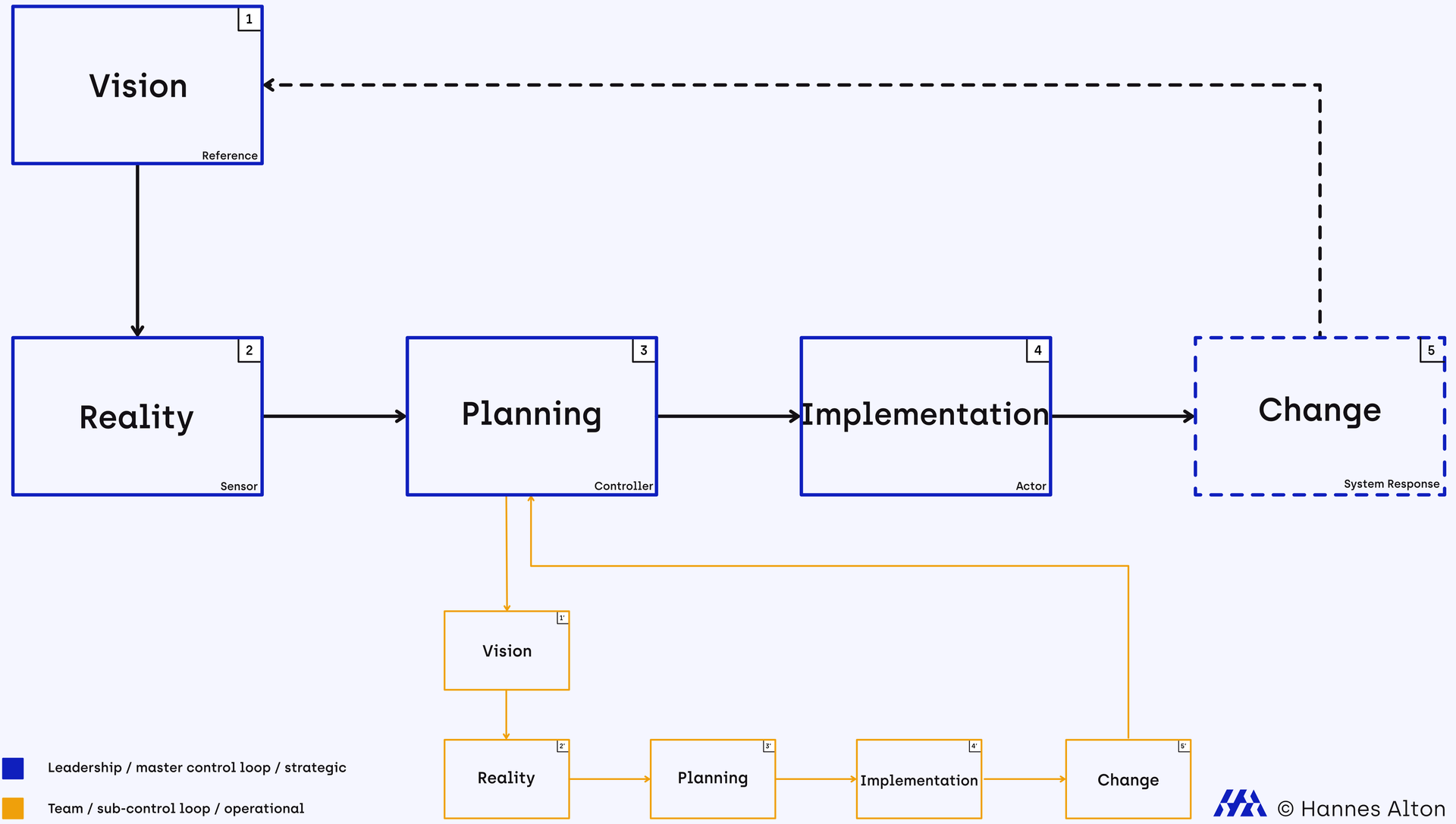Leading Change with Puzzle Transformation: A systems oriented approach
Change is a dynamic and continuous process. How can we lead these processes without losing control?
One part of the answer lies in the fact that Puzzle Transformation relies on the control loop principle, specifically on self-regulation and feedback. This creates a change process capable of learning and adapting, relying not on control through hierarchy but on control through structure.
Each of the five building blocks presented in the article Puzzle Transformation: An operating system for change has a clearly defined function:
- Clarification of goals/vision: What do we want to achieve?
- System diagnosis/reality: Where are we currently?
- Measure design/planning: What measures do we want to take to achieve our goal?
- Implementation/execution: How do we implement efficiently?
- System response/change: What works and what doesn't?

The structure of the master and sub-control loops follows fractal logic. Each sub-process reflects the structure of the overall system on a smaller scale.
The function of control loops
Control loops hold a special fascination for me.
Their structure is simple, yet capable of complexity without being unnecessarily complicated. Due to their self-similarity, it is sufficient to internalize the principle of the cybernetic control loop once to transfer it to different subsystems within the organization.
The division into master and sub-control loops protects the system from overload.
The tasks of the master control loop
How much time do managers have in their day-to-day work to deal with strategic issues?
From my own experience, I can tell you: not enough. Meetings, decisions, last-minute problems, and dealing with emails leave little room for the critical issues. In change processes, managers are more involved in operational activities than they usually are.
This impacts the quality of the decisions made.
The main tasks of the master control loop are:
- To ensure stability (through common alignment/coherence) without falling into micromanagement.
- Enabling scalability without overburdening people and the system.
- Ensuring control without losing control.
The master control loop enables management to refocus on its intended tasks: providing guidance, creating suitable conditions, and engaging in future-oriented strategic activities.
The tasks of the sub control loops
How much room for maneuver do teams in operational units have in change processes?
Here, too, my answer is: too little. Unclear priorities lead to multitasking, vague goals, and assigned responsibilities without decision-making authority, resulting in limited creative freedom. If people cannot understand the purpose of change initiatives, resistance is likely to occur.
Resistance slows down change initiatives, or the organization ends up in a seemingly endless spiral of change that leads to frustration and resignation.
The main tasks of the sub-control loops are:
- Implementation of established measures in areas targeted for change.
- Enabling adaptability without decoupling from the overarching framework.
- Ensuring practical relevance by developing context-specific solutions.
The sub-control loops provide individuals within the system with the opportunity to contribute to shaping change by becoming co-architects of the process. Within defined parameters, there is scope for self-effective, operational implementation.
Master and sub-control loops in direct comparison
| Master control loop | Sub control loop | |
|---|---|---|
| Function | Higher-level control & strategic alignment | Context-related adaptation & implementation |
| Focus I | Strategic: external & future | Operational: internal & present |
| Focus II | Strategic: vision, principles, orientation, coherence | Operational: measures, solutions, practical relevance |
| Responsibility | Strategic management & leadership | Teams & operational units |
| Level | Overall system | Subsystem |
| Main tasks | - Stability through common alignment - Enabling scalability - Ensuring control |
- Detailed development & implementation of measures - Adaptation without decoupling - Ensuring practical relevance |
| Feedback flow | Integrates findings from sub-control loops for further development | Informs master control loop about effects, experience, and barriers |
| Benefits | Stability, relief for management | Co-creation increases ownership and implementation quality |
„The art of progress is to preserve order in change and change in order.“ Alfred North Whitehead
Modularity to deal with complexity
Modularity is a proven approach for managing complexity. Puzzle Transformation uses this principle.
The more extensive the change projects are, the greater the risk of losing track or over-bureaucratizing the process to keep it manageable. Modularity offers an alternative. Both master and sub-control loops work as independent modules. Thanks to their self-similar (fractal) structure, they function as autonomous units that are connected to the overall system through feedback loops, serving as control mechanisms.
In practice, this means:
- There is one central master control loop,
- to which one or more sub-control loops are connected.
- The master control loop defines the information required for control and decision-making, and
- The sub-control loops provide this information.
By clearly focusing each control loop on a specific “system in focus”, complexity is reduced and thus made manageable. Regular coordination ensures that no isolated solutions arise that do not fit into the overall system, that the process remains controllable, and that continuous learning takes place.
Modularity relies on decentralization, which keeps change processes adaptable and flexible without becoming unstable.
Conclusion and outlook
Puzzle Transformation is an operating system for change that combines central control with decentralized implementation, reducing risks through modularization.
By breaking the system into control loops with distinct responsibilities, change processes become structured while remaining adaptable and capable of learning. Employees become co-architects of change, which reduces the risk of resistance to change.
The self-similar (fractal) structure and functioning of control loops ensure that the process is comprehensible at all levels of the organization. Puzzle Transformation thus becomes an operating system for change, enabling the company to embed adaptability in its corporate DNA.
One of the biggest challenges in change processes is determining where change should occur. This topic will be discussed in the upcoming article, which will be illustrated through the three modules of Vector3.
Would you like to implement Puzzle Transformation as an operating system for change in your company? Then let's get in touch.
Are you interested in training on the practical application of Puzzle Transformation?
Please feel free to contact me directly.



